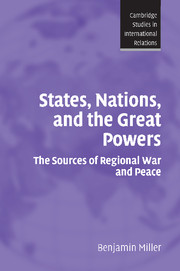Book contents
- Frontmatter
- Contents
- List of figures
- List of tables
- Preface and acknowledgments
- 1 Why some regions are peaceful and others are not
- 2 A theory of regional war and peace
- 3 States, nations, and war
- 4 Explaining the war proneness of the Middle East
- 5 The great powers war and peace in the Middle East
- 6 War and peace in the Balkans: states, nations, and great powers
- 7 The state-to-nation balance and the emergence of peace in South America during the twentieth century
- 8 The emergence of high-level peace in post-1945 Western Europe: nationalism, democracy, hegemony, and regional integration
- 9 Conclusions
- Appendix A Comparative dimensions of the state-to-nation imbalance in the Middle East, the Balkans, South America, and Western Europe in the post-1945 era
- Appendix B Data-file: major armed conflicts/wars by region, type, and modes of great power regional involvement (1945–2004)
- Bibliography
- Index
- Cambridge Studies in International Relations
7 - The state-to-nation balance and the emergence of peace in South America during the twentieth century
Published online by Cambridge University Press: 22 September 2009
- Frontmatter
- Contents
- List of figures
- List of tables
- Preface and acknowledgments
- 1 Why some regions are peaceful and others are not
- 2 A theory of regional war and peace
- 3 States, nations, and war
- 4 Explaining the war proneness of the Middle East
- 5 The great powers war and peace in the Middle East
- 6 War and peace in the Balkans: states, nations, and great powers
- 7 The state-to-nation balance and the emergence of peace in South America during the twentieth century
- 8 The emergence of high-level peace in post-1945 Western Europe: nationalism, democracy, hegemony, and regional integration
- 9 Conclusions
- Appendix A Comparative dimensions of the state-to-nation imbalance in the Middle East, the Balkans, South America, and Western Europe in the post-1945 era
- Appendix B Data-file: major armed conflicts/wars by region, type, and modes of great power regional involvement (1945–2004)
- Bibliography
- Index
- Cambridge Studies in International Relations
Summary
Potential pathways to regional peace
chapters 7 and 8 focus on the effects of two major mechanisms for regional peace — conflict resolution and integration — and on the domestic conditions for their success. I use the regional cases of South America (in this chapter) and Western Europe (in chapter 8) to illustrate these potential theoretical pathways to peace.
The degree of state-to-nation balance conditions the effectiveness of different peacemaking strategies. When there is a high state-to-nation imbalance in a region, strategies that focus on changing the capabilities of the local antagonists tend to be the most effective. In a regional context, those strategies are related to the type of involvement of the great powers in the region, especially hegemony or cooperation, which are discussed in chapters 5 and 6. However, when there is a relatively high extent of state-to-nation balance, peacemaking strategies that focus on changing the intentions of the regional parties can be effective. There are two major types of such regional strategies: conflict resolution and integration.
I make a distinction between the effects of approaches to peacemaking and the conditions for their success. Different peacemaking strategies may bring about a transition from war to peace, but each strategy will be successful only if certain distinctive conditions exist in the region. The conditions for the effectiveness of the different strategies vary considerably and stem from three levels of analysis.
- Type
- Chapter
- Information
- States, Nations, and the Great PowersThe Sources of Regional War and Peace, pp. 306 - 336Publisher: Cambridge University PressPrint publication year: 2007

